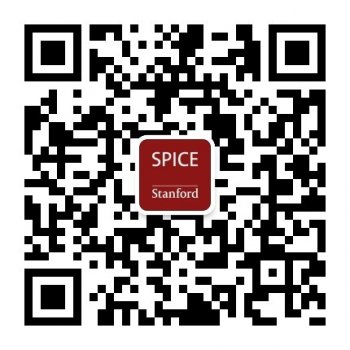Stanford e-China: Design Thinking into Action

Accepting Applications
January 30, 2025 - March 15, 2025
The application for the spring 2025 course is now open at https://spicestanford.smapply.io/prog/stanford_e-china_/.
Spring 2025 course dates: March 29 to May 31, 2025 (China Time)
Final deadline to apply: March 15, 2025. Applications are considered on a rolling basis.
Tuition: $4000 USD
Follow SPICE on WeChat (QR code below), Facebook, X, or Instagram and join our email list to receive announcements for the next application period.
Design Thinking into Action: Teen Well-Being (Adolescent Psychological and Physical Health)
Offered every spring and fall, Stanford University is offering a distance-learning opportunity to exceptional high school students and year 1–2 university students from China. This interactive, virtual course will introduce students to design thinking––a creative framework and mindset for human-centered innovation. In real-time seminars with leading Stanford University scholars and Silicon Valley entrepreneurs, students will participate in a rigorous learning experience as they apply basic aspects of the design thinking process to challenges in adolescent mental and physical health. In this English-language course, students will explore the concepts of empathy, ideation, prototyping, and iteration as they brainstorm innovative solutions to problems impacting the lives of youth. They will also delve into the concept of purpose learning. Through discussions, assignments, and a mini-design challenge, students will nurture an entrepreneurial mindset that they can apply to their academic and professional aspirations.
Students who successfully complete the course will receive a Certificate of Completion from SPICE, Stanford University.
Students will also gain practical, academic skills:
- Pre-recorded, university-level lectures by leading scholars from Stanford University offer practice listening to a variety of lecturing styles
- Real-time discussions led by guest lecturers familiarize students with the dynamics of classroom participation in schools such as Stanford University
- Short writing assignments improve critical thinking skills
- The final project requires students to investigate a challenge related to course themes, develop a compelling presentation, and practice oral English skills
Course components emphasize active participation and development of student interests:
- 10 “virtual classes” online in real time on Saturday mornings at 9:00 am Beijing time
- Weekly reading assignments of varying length and difficulty
- Required participation in virtual discussion boards with classmates
- Short writing assignments reflecting on readings and lectures
- Research in an area of interest related to course themes (with instructor guidance)
- Direction, facilitation, and support from the instructor throughout the course
Admission to this program is competitive; up to 30 exceptional students will be accepted. Requirements include:
- Enrollment in grades 10, 11, or 12 in a high school in China with exceptional academic experience, or in year 1 or 2 in a university in China
- Ability to read, write, and discuss complex ideas in English
- A complete application including a written personal statement, transcript, and availability for a virtual interview
- Availability for all or most of the virtual classes on Saturday mornings
- Ability to allot 3–4 hours per week for class preparation and assignments, on student’s own schedule
- Use of a personal computer, camera, microphone, and reliable access to a broadband Internet connection

For more information, please see the Frequently Asked Questions, contact Carey Moncaster (Stanford e-China Instructor) via email at cmoncaster@stanford.edu, or contact Liyi Ye (Stanford e-China Advisor in China) via WeChat at hiStanford.
